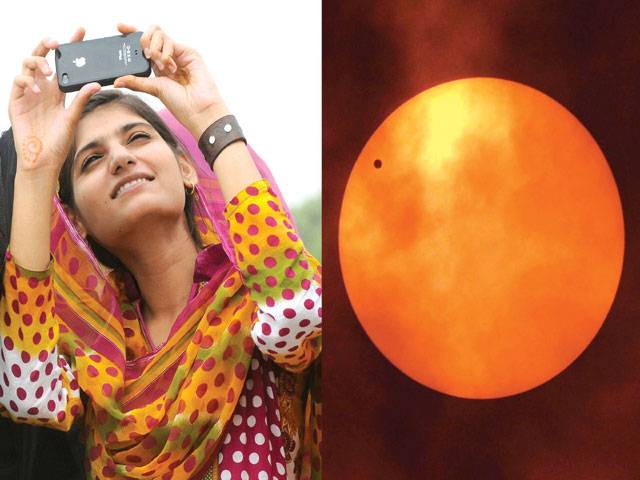PARIS - Astronomers and novice star-gazers worldwide trained their eyes and telescopes on the skies Wednesday for the last chance this lifetime to observe Venus track a near seven-hour path across the Sun.
The extraordinary event, only to be seen again in 105 years, began shortly after 2200 GMT on Tuesday, visible first from the Pacific and north and central Americas as a small black dot trailing across the solar surface.
Australia - for which the transit of the fiery planet carries a unique historical interest as a 1769 precursor contributed to the continent's discovery - presented one of the best vantage points. For Europe, the Middle East and South Asia, most of the event happened overnight, and impatient planetary observers had to wait until sunrise to observe the transit's final moments.
"After today, that's it. Probably no-one alive is going to see one of these again," the Royal Astronomical Society's Robert Massey told AFP after witnessing the event from the Cotswold hills in southwest England.
"For most of us, this was the last chance. I was very lucky; we didn't have very good weather but we actually managed to have a few holes in the clouds."
The planet named for the Roman goddess of beauty and love only rarely moves in a direct line between the Earth and the Sun, and the next transit will be in 2117. Only six transits have been observed since the telescope was invented: in 1639, 1761, 1769, 1874, 1882 and 2004 - happening in pairs eight years apart.
Cloud cover spoiled the rare opportunity for many around the world, including parts of Australia and much of Europe.
"I saw it for about, maybe at most 30 seconds to a minute once, and briefly for about 10 seconds after that. It wasn't the best view I've ever had, so I was delighted to see something," said Massey.
"We regrettably saw nothing from Paris," lamented Claude Catala, director of the Paris Observatory.
"It is the hard life of the astronomer."
European Space Agency (ESA) scientist Hakan Svedhem observed the passage from Svalbard, Norway - so far north that the Sun doesn't set in summer.
"It was a long night but it was very exciting and it was particularly nice to see it against the midnight Sun," he told AFP about an hour after Venus took its leave and slid off the solar disk just before 0500 GMT.
"It is a very spectacular sight to see."
To observers not using telescopes, the event would have appeared as a black dot about a 30th of the Sun's diameter, moving slowly over the star's northern hemisphere.
ESA's Venus Express is the only spacecraft orbiting the hot planet at present, and used the unique opportunity to study Venus' atmosphere.
"We can learn how to observe atmosphere on planets around other stars" similar to our Sun, said Svedhem - to determine whether they may be able to sustain life.
NASA's Hubble Space Telescope, which cannot view the sun directly, used the Moon as a mirror to capture reflected sunlight and study the fiery planet.
On Earth, Sydney Observatory held a sell-out viewing with 1,500 people buying tickets.
About 600 people gathered at the Goddard Space Flight Centre in the US state of Maryland to observe the planet also known as the Evening Star or Morning Star due to the bright sunlight it reflects early and late in the day.
And in Tahiti in French Polynesia, one of the best viewing spots, up to 2,000 people gathered on the beach at Venus Point, so named for the place where British navy captain James Cook observed the same momentous event in 1769.
Cook had charted the east coast of Australia on that same trip.
Venus is the second planet from the Sun, roughly the size of the earth, with no oceans and a lead-melting surface temperature.
In the 18th and 19th centuries, astronomers used the planet's transits to measure the distance from the Earth to the Sun.
Indian numerologist Swetta Jumaani said the event was an auspicious one, describing Venus as the planet governing love, peace, harmony and good luck.
"This transit across the sun will bring good luck and good fortune this year," she told AFP.
Thursday, April 25, 2024
Rare Venus transit draws attention worldwide

Pakistan to take on New Zealand in 4th T20I today
5:41 PM | April 25, 2024
IOC Refugees Olympic Team to be announced on May 2
5:38 PM | April 25, 2024
FC man martyred in Bannu gun attack
5:37 PM | April 25, 2024
Mohsin Naqvi reconstitutes women's selection committee
5:37 PM | April 25, 2024
Supreme Court reinstates Balochistan Assembly speaker, annuls ECP's decision
5:34 PM | April 25, 2024
Musk vs Australia
April 25, 2024
Reforming Rehab
April 25, 2024
Tax It Right
April 25, 2024
Academic Uprising
April 24, 2024
Cooperation Momentum
April 24, 2024
Ending animal suffering
April 25, 2024
AI governance
April 25, 2024
AI concerns
April 25, 2024
Population paradox
April 24, 2024
Unveiling differences
April 24, 2024
ePaper - Nawaiwaqt
Advertisement
Nawaiwaqt Group | Copyright © 2024





